Though I have no preferences for any of the above, but I eliminated 2) Magome/Tsumago as it is the only one that do not fall under japan-guide.com 'Best of Japan' sights. Actually I have recommended a friend the week after that we should visit Kamikochi or Ise in the future. So I hope the final decision will be Takayama. As luck should have it, it is the rainy season and Ise is out as the frontline of the rain will fall on Ise first. Then I mention that Kamikochi is too far away. Final verdict on Friday afternoon, on Saturday we will visit Takayama (高山). Yea!
Nakagawa-san came to fetch me with his SUV (see picture below) on Saturday morning at 8.30am.
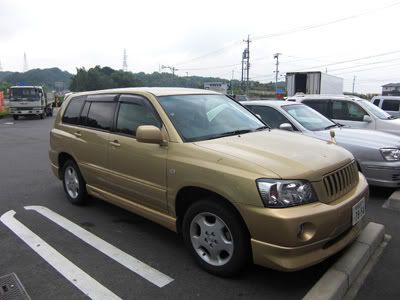
The journey takes 2 hours in all. I'm sitting in the middle with Shelly-san, while Nakagawa-san's 2 children are behind us with the parents in front. His 2 children are very active and feeling very happy. The boy is 4 years while the girl is only 2.
We left Komaki city and went up north along the expressway and mountain road. It passes by 'Japan's Rhine' - Kiso gawa. I took a photo of a red bridge below.
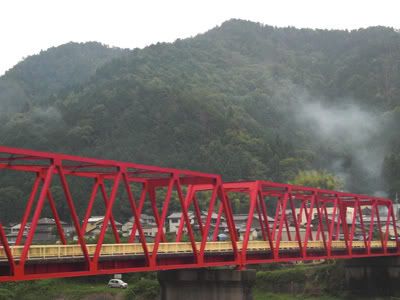
We went further up the mountain passes where the car drove through endless tunnels and zig-zag roads. We finally arrived at a flower farm which is 40km before Takayama. Beds of violet flowers line the stretch along the road. A break was taken there and we went on down for a photoshot. These are actually Lavender flowers. Nakagawa-san mentioned that these are actually used to make perfumes and fragrances. If we were to press the flower bud, we can scent the fragance smell on our fingers.
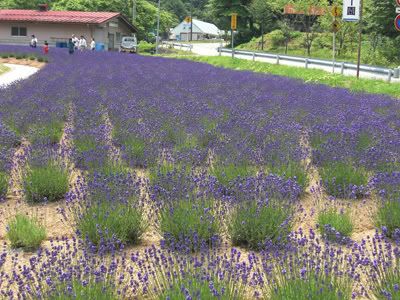
There are butterflies and bees going round the flowers. I took a close up shot of a bee below.
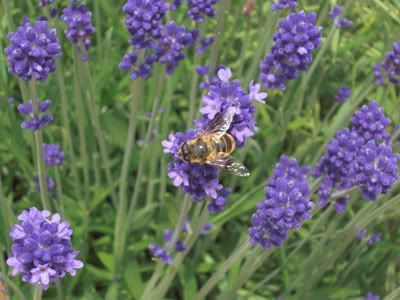
Just next to the farm is Kiso-gawa again. There are many people fishing along the river. The weather is cooling. It is neither hot or cold, just naturally cooling, perfect for an outdoor trip. The stretch along the farm has some beautiful river-mountain scenery.
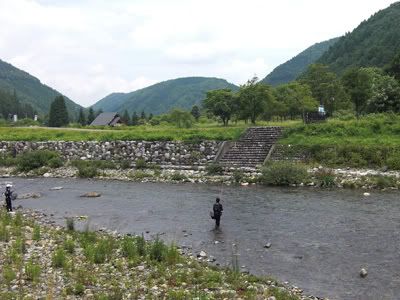
We proceeded on our journey and arrived at Takayama around 12noon. This is the first time I'm not the tour guide. But I have the map memorised just in case. Our first activity for the day in Takayama is Lunch. Suzuki-san (refer to Singapore Tour 2008) recommended Nakagawa-san to go this restaurant - Kitchen HIDA. It serves Hida beef (飛騨牛), which is consider one of Japan's top 3 beef together with Kobe and Matsusaka.
I took a family photo of Nakagawa-san with his wife and children below.
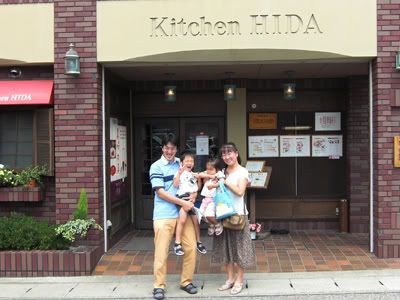
And a photo of Shelly and me with the kids.
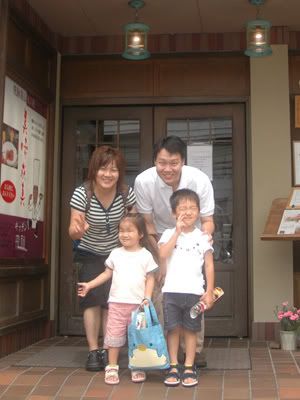
I went through a bit of beef-type orientation before the meal. There are different grades of beef. The superior one are the A-5 type which goes for 5,500 Yen for 100g. The A4 are split into two categories, the A-4 fillet type is 3,300 Yen (there's no fat in it) and the A-4 steak version is 4,200 Yen. And also the more normal A-3 type which is 2,800 Yen. The steak version has fat in it makes the entire meat tender. I went for the A-4 steak version set meal, as can be seen in the picture below.
The beef is definitely many times better than the 38RMB ones which I had in China. Hida beef taste really good. I have to admit, I don't really take beef once I'm back in Singapore.
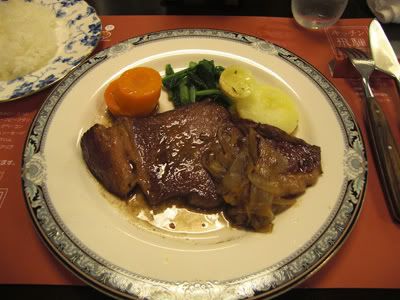
After lunch, we cross over the road to Takayama Jinya (高山陣屋). Note the word Jinya, it is not Jinja which means shrine in Japanese (or Ninja). It is actually an old administrative building for the Takayama city and the current building dates back 200 years from the Tokugawa shogun period. We took a photo shot below. Nakagawa-san was the photographer.
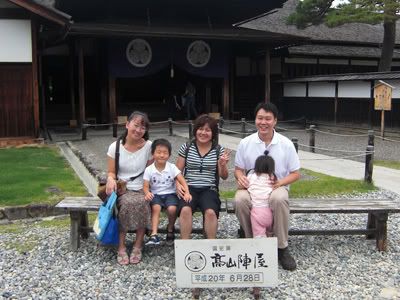
We spent quite a bit of time here (around an hour). As there is an English tour going around just nice after I arrived, I decided to join in. The rest were going around the different rooms themselves while the kids are rolling on the tatami mats.
Here is one of the rooms after the entrance.
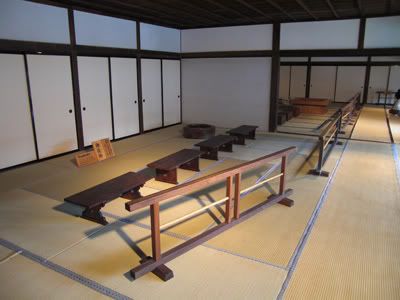
A garden in the Jinya.

The guided tour was quite good. From it I learnt quite a few stuff. One of which is the 'natural technology' which they used. See the picture below. You will notice a pot hanging from the ceiling top. This is where the people lit fires and hot their food and water. In those days u can't really control how hot you want the fire to be after you have started it. To heat the pot more or less than before, you have to alter the height of the pot. You do that by just shifting the hammer-like device in the middle. It is simple as that. It just uses the laws of friction and gravity to control the height easily.
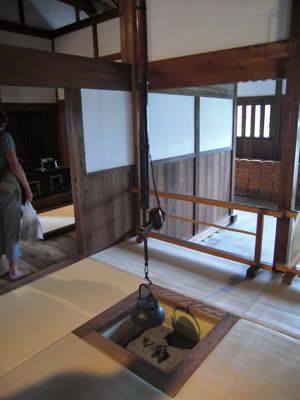
The second interesting mechanism is the door lock. Look at the picture below. It does not use any screws or nuts. Just a natural wooden bolt. It is in its locking state now. To unlock it, just shift the L-shape frame below to the left and the bolt will drop. Simple as that.
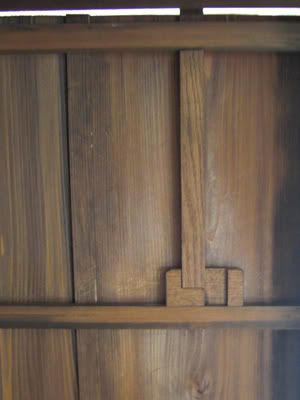
We went through all the rooms and halls and saw the audience chamber. The words 'Piety' and 'Loyalty' are written on the wall.
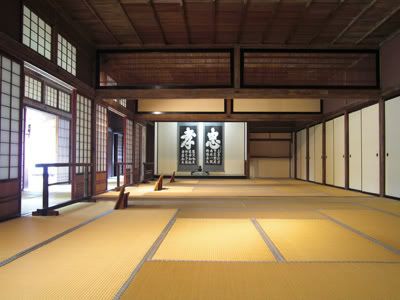
We left the Jinya around 3pm and went on down to the Old Street just across the river. Takayama town is famous for its rice crackers and rice snacks. Nakagawa-san gave us a treat of the rice snacks below. Haha. The kids are having them.
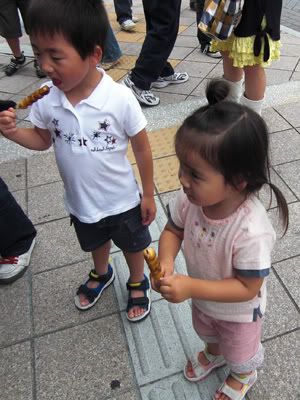
The Old Street is called Sanmachi, which means three streets. The buildings are carefully preserved. In the buildings are actually shops (souvenir shops) and museums.
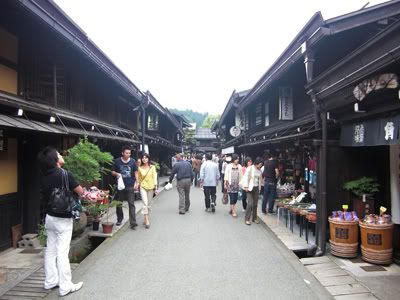
We spent the next 2 hours here shopping. Takayama is also famous for its faceless monkey - Sarubobo.
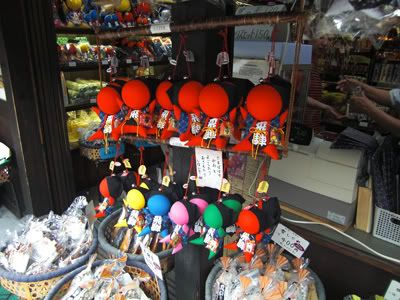
A traditional looking lamp along the street.
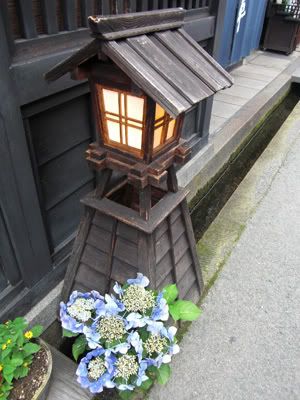
At the end of the first street across the road, we came upon this shop selling Hida Milk. What I find fascinating about it is that there are no one collecting money for purchases made from this fridge. The prices are written there below, 110Yen each. You pay by putting money into the coin can you see at the top. If you want change, you also get from there. This is absolute honesty at its best. The shopowner trusts his customers and the customers likewise will respect their purchases. I'm not sure whether can I find such a system elsewhere in the world. I have never seen it in Singapore.

We went along the second street and I find one of the shops to be fascinating. There is a garden in there where people can sample tea and enjoy the natural surroundings.
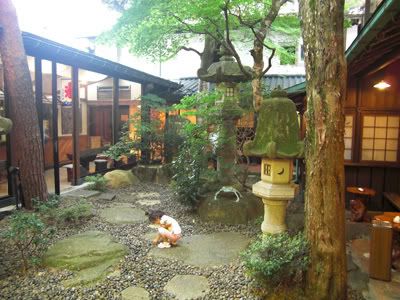
I took a quick snapshot with Nakagawa-san's children. They are really kawaii.
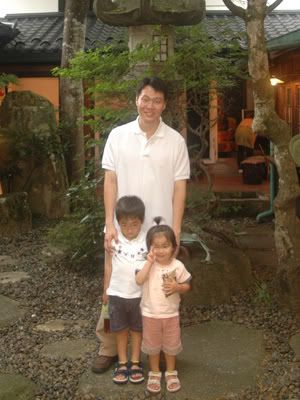
We left around 5.30pm. It started to drizzle a bit, only minor droplets. The rain intensified when we passed by Kiso-gawa but it shopped again when we got to Nagoya for our dinner. Nakagawa-san treated us to Omelette rice that evening. He sent us back and I got back to my dorm around 10pm. We were lucky to travel on the Saturday instead of Sunday as the main downpour came on the Sunday and it just rain endlessly. It is also a good time to update my blog.
I am grateful to Nakagawa-san for organising this trip for us.